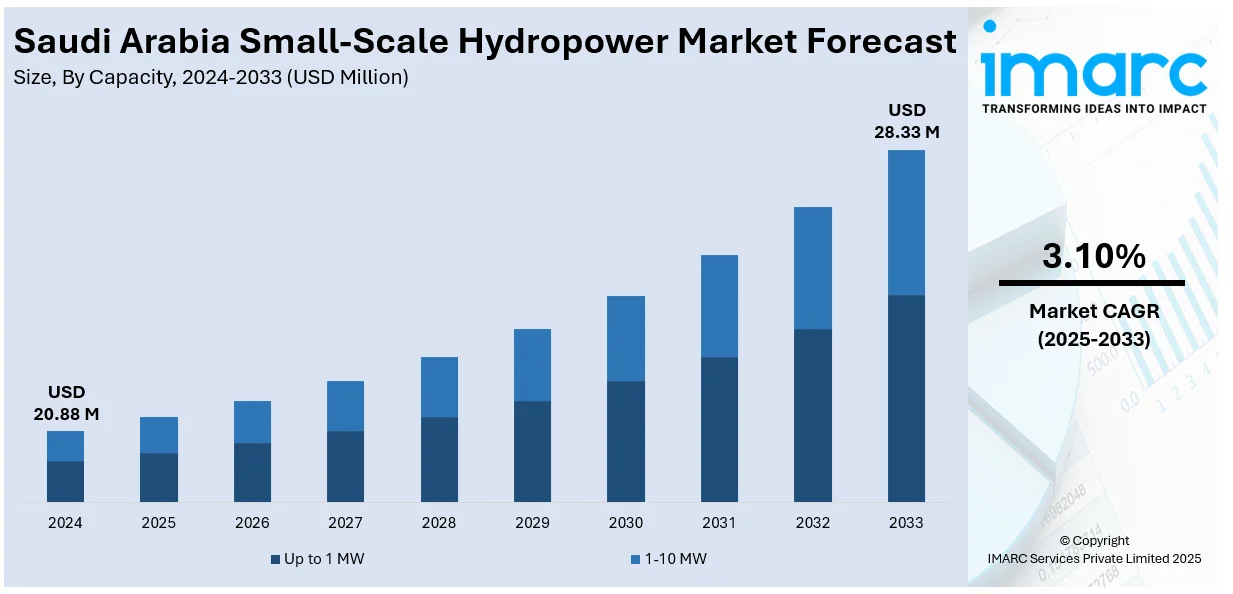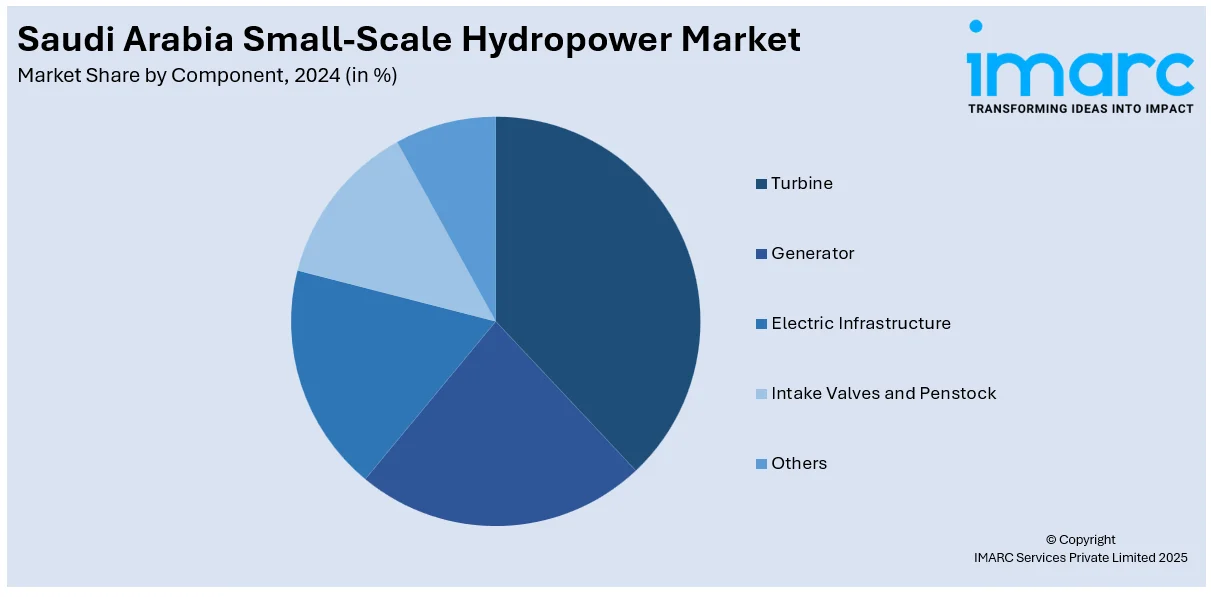
Saudi Arabia Small-Scale Hydropower Market Size, Share, Trends and Forecast by Capacity, Component, and Region, 2025-2033
Saudi Arabia Small-Scale Hydropower Market Overview:
The Saudi Arabia small-scale hydropower market size reached USD 20.88 Million in 2024. Looking forward, IMARC Group expects the market to reach USD 28.33 Million by 2033, exhibiting a growth rate (CAGR) of 3.10% during 2025-2033. The market is witnessing significant growth, driven by growing interest in renewable energy diversification and sustainable water management. With limited natural water flow, the focus is on utilizing existing dam infrastructure and integrating micro-hydro systems for rural and agricultural applications. Government support under Vision 2030 and pilot renewable projects are paving the way for adoption, contributing to the expanding Saudi Arabia small-scale hydropower market share.
|
Report Attribute
|
Key Statistics
|
|---|---|
|
Base Year
|
2024 |
|
Forecast Years
|
2025-2033
|
|
Historical Years
|
2019-2024
|
| Market Size in 2024 | USD 20.88 Million |
| Market Forecast in 2033 | USD 28.33 Million |
| Market Growth Rate 2025-2033 | 3.10% |
Saudi Arabia Small-Scale Hydropower Market Trends:
Growing Support under Vision 2030
Saudi Arabia’s Vision 2030 is a central force behind the country’s exploration of small-scale hydropower as a supplementary renewable energy source. The national blueprint emphasizes reducing dependence on oil and expanding the share of renewables in the energy mix. Although the Kingdom has limited natural hydropower potential due to its arid climate, Vision 2030 encourages the evaluation of non-conventional solutions like micro and pico hydro systems integrated with existing water infrastructure. These systems are particularly attractive for powering remote facilities, agricultural operations, and water treatment plants. Government-backed research, pilot projects, and financial incentives are supporting feasibility studies and technology trials. Additionally, policy frameworks promoting environmental sustainability and energy diversification are driving the push for cleaner, decentralized power generation. This strategic alignment is gradually shaping a role for small-scale hydropower within Saudi Arabia’s broader renewable energy agenda.

Integration with Existing Water Infrastructure
A key driver of the Saudi Arabia small-scale hydropower market growth is the strategic focus on integrating micro-hydro systems within existing water infrastructure. Given the country's limited natural watercourses, efforts are concentrated on retrofitting turbines into dams, irrigation canals, desalination discharge systems, and water distribution pipelines. These modifications allow for energy generation without requiring new large-scale hydro installations or altering natural water flows, making them environmentally and economically practical. Government agencies and private firms are increasingly exploring these opportunities to harness otherwise wasted hydraulic energy. This approach also aligns with water conservation goals and supports sustainable agriculture and rural electrification. By utilizing existing assets, Saudi Arabia can achieve cost-efficient renewable energy production while minimizing land and environmental disruption. This infrastructural integration is expected to significantly contribute to Saudi Arabia small-scale hydropower market growth in the coming years.
Growing Emphasis on Decentralized Energy Solutions
Saudi Arabia is witnessing increased interest in decentralized energy systems, particularly for rural and agricultural regions with limited grid access. This shift is driving demand for small-scale and off-grid hydropower solutions that can operate independently and deliver reliable electricity to remote locations. Compact hydro systems such as micro and pico turbines are being explored as viable options for powering irrigation pumps, small farms, and water treatment units. These systems offer low maintenance and long-term cost benefits, making them attractive for community-level energy projects. The push for energy equity and rural development under national policies aligns with the adoption of localized generation sources. Additionally, small-scale hydropower complements other renewables like solar, creating hybrid models suited for varied environmental conditions. This localized focus is playing a pivotal role in shaping future deployment strategies and expanding the reach of Saudi Arabia’s renewable energy portfolio.
Saudi Arabia Small-Scale Hydropower Market Segmentation:
IMARC Group provides an analysis of the key trends in each segment of the market, along with forecasts at the country and regional levels for 2025-2033. Our report has categorized the market based on capacity and component.
Capacity Insights:
- Up to 1 MW
- 1-10 MW
The report has provided a detailed breakup and analysis of the market based on the capacity. This includes up to 1 MW and 1-10 MW.
Component Insights:

- Turbine
- Generator
- Electric Infrastructure
- Intake Valves and Penstock
- Others
A detailed breakup and analysis of the market based on the component have also been provided in the report. This includes turbine, generator, electric infrastructure, intake valves and penstock, and others.
Regional Insights:
- Northern and Central Region
- Western Region
- Eastern Region
- Southern Region
The report has also provided a comprehensive analysis of all the major regional markets, which include Northern and Central Region, Western Region, Eastern Region, and Southern Region.
Competitive Landscape:
The market research report has also provided a comprehensive analysis of the competitive landscape. Competitive analysis such as market structure, key player positioning, top winning strategies, competitive dashboard, and company evaluation quadrant has been covered in the report. Also, detailed profiles of all major companies have been provided.
Saudi Arabia Small-Scale Hydropower Market Report Coverage:
| Report Features | Details |
|---|---|
| Base Year of the Analysis | 2024 |
| Historical Period | 2019-2024 |
| Forecast Period | 2025-2033 |
| Units | Million USD |
| Scope of the Report | Exploration of Historical Trends and Market Outlook, Industry Catalysts and Challenges, Segment-Wise Historical and Future Market Assessment:
|
| Capacities Covered | Up to 1 MW, 1-10 MW |
| Components Covered | Turbine, Generator, Electric Infrastructure, Intake Valves and Penstock, Others |
| Regions Covered | Northern and Central Region, Western Region, Eastern Region, Southern Region |
| Customization Scope | 10% Free Customization |
| Post-Sale Analyst Support | 10-12 Weeks |
| Delivery Format | PDF and Excel through Email (We can also provide the editable version of the report in PPT/Word format on special request) |
Key Questions Answered in This Report:
- How has the Saudi Arabia small-scale hydropower market performed so far and how will it perform in the coming years?
- What is the breakup of the Saudi Arabia small-scale hydropower market on the basis of capacity?
- What is the breakup of the Saudi Arabia small-scale hydropower market on the basis of component?
- What is the breakup of the Saudi Arabia small-scale hydropower market on the basis of region?
- What are the various stages in the value chain of the Saudi Arabia small-scale hydropower market?
- What are the key driving factors and challenges in the Saudi Arabia small-scale hydropower market?
- What is the structure of the Saudi Arabia small-scale hydropower market and who are the key players?
- What is the degree of competition in the Saudi Arabia small-scale hydropower market?
Key Benefits for Stakeholders:
- IMARC’s industry report offers a comprehensive quantitative analysis of various market segments, historical and current market trends, market forecasts, and dynamics of the Saudi Arabia small-scale hydropower market from 2019-2033.
- The research report provides the latest information on the market drivers, challenges, and opportunities in the Saudi Arabia small-scale hydropower market.
- Porter's five forces analysis assist stakeholders in assessing the impact of new entrants, competitive rivalry, supplier power, buyer power, and the threat of substitution. It helps stakeholders to analyze the level of competition within the Saudi Arabia small-scale hydropower industry and its attractiveness.
- Competitive landscape allows stakeholders to understand their competitive environment and provides an insight into the current positions of key players in the market.
Need more help?
- Speak to our experienced analysts for insights on the current market scenarios.
- Include additional segments and countries to customize the report as per your requirement.
- Gain an unparalleled competitive advantage in your domain by understanding how to utilize the report and positively impacting your operations and revenue.
- For further assistance, please connect with our analysts.
 Request Customization
Request Customization
 Speak to an Analyst
Speak to an Analyst
 Request Brochure
Request Brochure
 Inquire Before Buying
Inquire Before Buying




.webp)




.webp)












